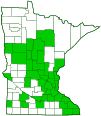hairy puccoon
(Lithospermum caroliniense var. croceum)
Conservation • Description • Habitat • Ecology • Use • Distribution • Taxonomy
Conservation Status |
|
|||||||
| IUCN Red List | not listed |
|||||||
| NatureServe | N4? - Apparently Secure SNR - Unranked |
|||||||
| Minnesota | not listed |
|||||||
Description |
||
Hairy puccoon is a 6″ to 24″ tall, erect, perennial forb that rises on 1 to 12 or more stems from a stout, woody root. The stems are erect and usually unbranched, though sometimes branched near the top. They are roughly hairy. The hairs on the stem have small, elevated, blister-like elevations (pustules) at the base. The leaves are alternate, stalkless, relatively thick, linear to lance-shaped, 1⅛″ to 2⅜″ long, and ⅛″ to ½″ wide. There are usually more than 25 crowded leaves below the inflorescence. They are angled or narrowly rounded at the base and bluntly pointed at the tip. Sometimes there is a minute, sharp point at the tip. There is a single prominent vein and no noticeable lateral veins. The upper and lower surfaces are grayish-green to green and roughly hairy. There are small, elevated, blister-like elevations (pustules) at the base of the hairs on the leaves. The margins are untoothed and have a fringe of soft hairs. The inflorescence is 1 to 3 leafy, branched, flower clusters at the end of the stem and branches. The flowers at the top bloom first, the lateral flowers progressively later. The clusters are dense at first, elongate as the lateral flowers bloom, eventually becoming coiled and 2″ to 10″ long. The flowers are ½″ to 1″ wide and funnel-shaped. There are no closed, self-fertilizing (cleistogamous) flowers. The sepals are fused at the base into a short, cup-like structure (calyx) then separated into 5 linear, flat, ¼″ to ½″ long lobes. The 5 petals are orange to yellow. They are fused at the base into a 9 ⁄16″ to 1″ long floral tube, then separated into 5 spreading, ⅝″ to 1″ wide lobes. The lobes are not fringed. There are 5 stamens. The flowers are subtended by bracts that are much longer than the calyx. There is no floral scent. The fruits are 1 to 4 egg-shaped, ⅛″ long, white, smooth, shiny, hard nutlets. Each nutlet contains 1 seed. |
||
Height |
||
6″ to 24″ |
||
Flower Color |
||
Orange to light golden yellow |
||
Similar Species |
||
Fringed puccoon (Lithospermum incisum) inflorescence does not elongate as the season progresses. The floral tube is much longer, ¾″ to 2″ long. In the late spring and summer it becomes much branched with cleistogamous flowers in the leaf axils of the new branches. Hoary puccoon (Lithospermum canescens) rises on 5 or fewer stems. The stems are less leafy. The leaves are densely, softly hairy, not rough. The hairs on the stem and leaves are not pustule-based, though this may not be apparent without a hand lens. The inflorescence, when fully elongated, is much shorter, 1″ to 4″ long. The flowers are smaller, ⅓″ to ½″ wide. The calyx lobes are shorter, ⅛″ to ¼″ long when the plant is in full flower. The floral tube is shorter, ¼″ to ⅜″ long. The fruit is cream-colored, not white. |
||
Habitat |
||
Dry. Prairies, open woods, inland sands. In sandy soil. |
||
Ecology |
||
Flowering |
||
May to July |
||
Pests and Diseases |
||
|
||
Use |
||
|
||
Distribution |
||||
|
Sources |
|||
| 9/2/2022 | ||||
Nativity |
||||
Native |
||||
Occurrence |
||||
|
||||
Taxonomy |
|||
| Kingdom | Plantae (Plants) | ||
| Division | Tracheophyta (Vascular Plants) | ||
| Subdivision | Spermatophytina (Seed Plants) | ||
| Class | Magnoliopsida (Dicots) | ||
Order |
Boraginales (borages) | ||
Family |
Boraginaceae (borage) | ||
| Subfamily | Boraginoideae | ||
| Tribe | Lithospermeae | ||
Genus |
Lithospermum (stoneseeds, puccoons, and gromwells) | ||
Subordinate Taxa |
|||
|
|||
Synonyms |
|||
Lithospermum caroliniense ssp. croceum Lithospermum croceum |
|||
Common Names |
|||
Carolina gromwell Carolina puccoon hairy puccoon puccoon |
|||
Glossary
Axil
The upper angle where the leaf stalk meets the stem.
Calyx
The group of outer floral leaves (sepals) below the petals, occasionally forming a tube.
Cleistogamous
Automatically self-pollinating. Refers to bud-like flowers that do not open but automatically self-pollinate, or to plants with such flowers.
Linear
Long, straight, and narrow, with more or less parallel sides, like a blade of grass.
Pustule
Small, elevated, blister-like elevations, usually at the base of hairs.
Sepal
An outer floral leaf, usually green but sometimes colored, at the base of a flower.
“Larger, Lighter, Longer”
For a convenient mnemonic to distinguish between hairy puccoon and hoary puccoon in the field, think “Larger, Lighter, Longer." Hairy puccoon has larger petals that are slightly but noticeably lighter in color and have longer floral tubes.
Visitor Photos |
|||||
Share your photo of this plant. |
|||||
| This button not working for you? Simply email us at info@MinnesotaSeasons.com. Attach one or more photos and, if you like, a caption. |
|||||
Luciearl |
|||||
Carolina puccoon bloom later (early/mid June) than hoary puccoon(early May) Carolina is slightly brighter yellow. Found in same conditions, dry, sandy/gravel ditches. |
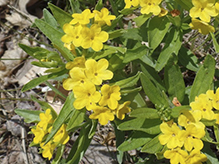 |
||||
Nancy Falkum |
|||||
Prairie Larkspur and puccoon at TNC Cox Unit |
|||||
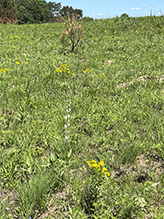 |
|||||
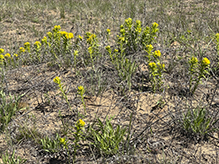 |
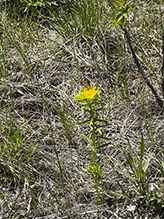 |
||||
Hairy Puccoon, Rose, and June Grass |
|||||
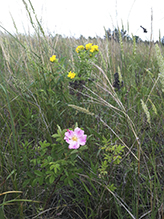 |
|||||
Bird’s Foot Violet, Hairy Puccoon, and Lyre Leaved Rock Cress |
|||||
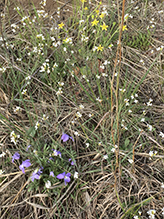 |
|||||
MinnesotaSeasons.com Photos |
|||||
Plant |
|||||
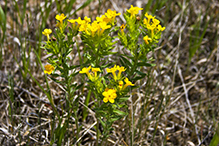 |
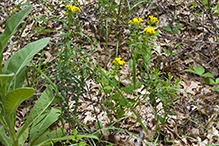 |
||||
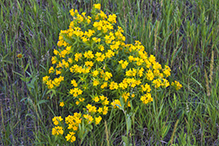 |
|||||
Inflorescence |
|||||
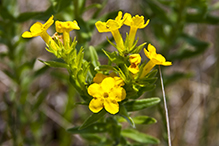 |
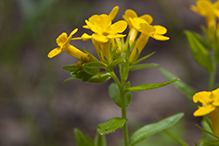 |
||||
Flowers |
|||||
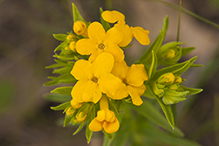 |
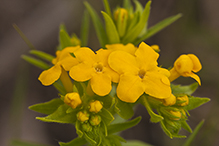 |
||||

Slideshows |
||

Visitor Videos |
|||
Share your video of this plant. |
|||
| This button not working for you? Simply email us at info@MinnesotaSeasons.com. Attach a video, a YouTube link, or a cloud storage link. |
|||
Other Videos |
|||


|
Created: Last Updated: © MinnesotaSeasons.com. All rights reserved. |
